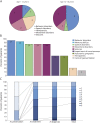Long-term neuropsychological outcome following pediatric anti-NMDAR encephalitis
- PMID: 29703768
- PMCID: PMC5980521
- DOI: 10.1212/WNL.0000000000005605
Long-term neuropsychological outcome following pediatric anti-NMDAR encephalitis
Abstract
Objective: To provide detailed long-term outcome data of children and adolescents following pediatric anti-N-methyl-d-aspartate receptor (anti-NMDAR) encephalitis, to identify neuropsychological impairments, and to evaluate the influence of these factors on quality of life (QoL).
Methods: All Dutch children diagnosed with anti-NMDAR encephalitis were identified. Patients currently aged 4 years or older were included in the follow-up study, consisting of a visit to our clinic for a detailed interview and a standardized neuropsychological assessment. The following domains were included: attention, memory, language, executive functioning, QoL, and fatigue. Primary outcome measures were z scores on sustained attention, long-term verbal memory, QoL, fatigue, and working memory.
Results: Twenty-eight patients were included. Median Pediatric Cerebral Performance Category at last visit was 1 (interquartile range 1-2, range 1-4), and 64% (18/28) of patients returned consistently to their previous school level. Twenty-two patients were included in the cross-sectional part of the long-term follow-up study. Median follow-up time was 31 months (interquartile range 15-49, range 5-91). There were problems with sustained attention (z = -2.10, 95% confidence interval = -2.71 to -1.46, p < 0.0001) and fatigue (z = -0.96, 95% confidence interval = -1.64 to -0.28, p = 0.008). Cognitive deficits were not correlated with QoL, while fatigue was strongly correlated with QoL (r = 0.82, p < 0.0001).
Conclusions: Although follow-up is often reported as "good" following pediatric anti-NMDAR encephalitis, many patients have cognitive problems and fatigue, even up until adolescence, resulting in academic achievement problems and lower QoL. For physicians, it is essential to be aware of these problems, to provide valuable advice to patients and caregivers in the acute and follow-up phase, and to consider early neuropsychological counseling.
Copyright © 2018 The Author(s). Published by Wolters Kluwer Health, Inc. on behalf of the American Academy of Neurology.
Figures



References
-
- McKeon GL, Scott JG, Spooner DM, et al. . Cognitive and social functioning deficits after anti-N-methyl-D-aspartate receptor encephalitis: an exploratory case series. J Int Neuropsychol Soc 2016;22:828–838. - PubMed
-
- Loughan AR, Allen A, Perna R, Malkin MG. Anti-N-methyl-D-aspartate receptor encephalitis: a review and neuropsychological case study. Clin Neuropsychol 2016;30:150–163. - PubMed
Publication types
MeSH terms
LinkOut - more resources
Full Text Sources
Other Literature Sources
